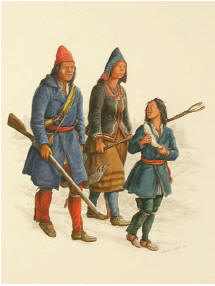Search
Website Design and Content © by Eric Krause,
Krause House Info-Research Solutions (© 1996)
All Images © Parks Canada Except
Where Noted Otherwise
Report/Rapport © Parks Canada / Parcs Canada
---
Report Assembly/Rapport de l'assemblée © Krause
House
Info-Research Solutions
Researching the
Fortress of Louisbourg National Historic Site of Canada
Recherche sur la Forteresse-de-Louisbourg Lieu historique national du Canada
Extracts of Matters of Historical Interest from "The Huissier, News For and About the Fortress of Louisbourg Heritage Presentation Staff" By The Fortress of Louisbourg Heritage Presentation Staff
THE HUISSIER
(July 15, 2006)
Mi’kmaw Man's Costume (July 15, 2006), by Elizabeth Tait
 |
Mi’kmaw Man’s Costume Much of the information used to reproduce the most recent Mi’kmaw scout costume comes from two reports written for the Fortress of Lousbourg. The first report, “Costume Report: MicMac, Male, War, c. 1744”, was written in 1978 by Ruth Whitehead. In 1996, Trudy Sable was asked to “up-date” Ms. Whitehead’s report, by including any new information about Mi’kmaw men’s costume in a revised report. At the same time, Ms. Sable wrote a report about Mi’kmaw women’s costume. All of these publications are available through the library at the Fortress of Louisbourg. Francis Back, whose illustrations of Mi’kmaw men and women are on display in the De la Plagne exhibit, has done detailed research on the Canadian capote (a type of coat), information which was also very useful.
Mi’kmaq were trading with Basque fishermen as early as the 1500’s, so by the mid- 18th century, after years of contact, the Mi’kmaq were using European trade cloth to make much of their clothing. According to Whitehead, in her book Elitekey, “The period 1600-1750 saw a phasing out of many materials and techniques utilized in pre-contact Micmac costume, infavour of cloth, ribbon, beads and ready-made European clothing.”
French-made, linen shirts were sought after by the Mi’kmaq. A number of writers of the time mention them as being worn by both men and women. According to Whitehead, the Mi’kmaw scouts at Louisbourg would have had ample opportunity to trade or to be presented with European linen shirts. The leggings and loincloth are a combination of European and traditional Mi’kmaw clothing. They are made of wool fabric, which by the 1700’s was used in the construction of this garment.
The leggings consist of tubes of fabric, sewn up along the outside of the leg, with a flap, extending four fingers wide on the outside. They tie on to a belt worn at the waist. The loincloth also passes through the belt leaving a length of fabric hanging down at the front and the back. The leggings are tapered to fit more closely to the leg. Ms. Sable points out that this, more tailored legging, would have allowed for easier movement through the woods, where wider leggings would have caught on tree branches. Robert-Lionel Séguin describes Quebecois men adopting this style of dress from the native people.
In her report, Ruth Whitehead did not recommend the use of a coat, but instead, a blanket. However, Francis Back compiled a list of goods given to Acadian Mi’kmaq between 1691-98 and found that lengths of cloth were given to the Mi’kmaw in order to make “capot”. The capote was a type of coat, with a hood, worn first by fishermen and sailors. In the 18th century, it retained some of the features of the early mariner coat as well as some of the features of a fashionable justaucorps. For example, the pleats in the skirt of the coat, the cuffs and the shape of the pattern pieces were all similar to a justaucorps. However, the capote was less expensive to produce as it was not lined and had only one button at the top. It was also worn belted at the waist. Blue was a popular colour for these garments. In 1750 Peter Kalm noted blue and red cloth used by native people.
Another traditional element of Mi’kmaw costume, which did not change, was moccasins. These too were adopted by Europeans as a practical type of footwear, and are occasionally seen in the Louisbourg inventories. Our plan is to add moccasins to our Mi’kmaw scout costume when appropriate ones are made.